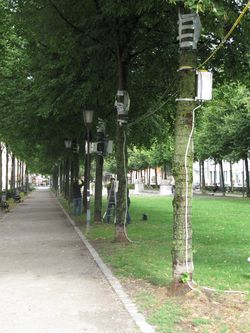SP7: Microclimate-Green Infrastructure Interactions


Head: Prof. Dr. Stephan Pauleit
Execution: Nayanesh Pattnaik
Background
There is strong evidence on urban cooling and run-off reduction via different types of UGI, with trees being mostly emphasized. Interestingly, these ESS are directly linked to the tree–water relationships, since the soil–plant–atmosphere continuum is the most critical determinant of gas exchange rates. However, understanding the dynamic relationships between ecological structure, function and ESS generated by urbangreenspaces in highly heterogeneous urban environments is yet a big challenge. The contributions of different types of vegetation and interaction between green and grey infrastructure in terms of ESS using a holistic approach is limited. The project aims towards two major impacts: improved human well-being and climate resilience, in particular, increase the quality and quantity of urban greenspaces, improvement of cooling effect, and decrease of heat stress. These impacts would be assessed using the ratio of open spaces to built-form, temperature reduction, and increased evapotranspiration through a measuring and modeling approach.
Background
The underlying objective is to understand the interaction of different types of surface coverage with or without vegetation, their spatial heterogeneity, as well as their vegetation dynamics such as annual cycles of water use, plant growth, and phenology.
Specifically, we want to understand the effect of:
- (O1) Surface coverage types on spatio-temporal variation in energy and water flux;
- (O2) Plant traits determining the intensity and extension of various ESS provision;
- (O3) Interaction between microclimate and surface coverage characteristics.
We postulate:
- (H1) Increasing UGI will improve the thermal comfort at all spatial and temporal scales;
- (H2) Trees provide higher cooling and water retention benefits compared to grass or shrubs;
- (H3) The built environment with less open space has an extended effect on heat trapping.
Methods
The subproject will result in new knowledge on the functioning of multilayered urban greenspaces and outdoor climate modification intensity for current and future climate conditions. Within stage 1, sampling sites will be selected in coordination with other subprojects (SP8 - Urban Trees, SP13 - Plant Systems, SP10 - Urban Drainage Systems) to represent important open space types such as streets and squares in densely built versus low density built. Attempts will be made to include four types of coverage namely impervious surface, shrub-grass, tree-grass and tree-shrub-grass to collect both continuous and sampled field data on meteorological and edaphic variables. Mobile and permanent weather stations will be used to measure bio-meteorological variables such as radiation, wind, temperature, humidity, black globe temperature, and edaphic variables such as soil temperature and moisture. Moreover, physical properties of each surface cover type along with the structural data such as leaf area index, diameter, and height of trees shrubs, and grasses will be collected. Data will be used to estimate shading depth and area, and sensible heat fluxes. Simultaneously, transpiration of trees using TDP sap flow sensors, shrubs (porometer) and grass (lysimeter) will be measured to calculate latent heat fluxes and crop coefficients. During stage 2, functional relationships between tree growth and water balances will be investigated using leaf water potential, chlorophyll content measurements, and soil hydraulic conductivity. Total transpiration, interception water loss and infiltration rate will be used to understand water balance and runoff coefficient. In stage 3, UGI parameters such as amount of vegetation, leaf area index, composition of the vegetation, and its connectivity will be systematically varied to develop and test prototypical UGI for cooling. Modeling is intended to be linked to the subproject on Indoor Comfort and Energy Consumptions of Buildings (SP6). Additionally, interactions are expected with the research on novel plant systems (SP13).